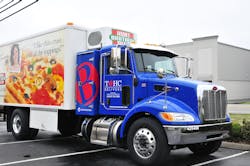Case study: How one truck fleet is transitioning to a fear-free workplace
April 30, 2015
5 min read
TBHC Delivers is on a mission to eliminate fear from the workplace – and it believes it has become better for it. The company, which operates a fleet of 73 trucks and employs 84 drivers, has implemented a fear-free work environment for its employees, meaning employees should be absent of the fear of accountability when they think of workplace safety. According to Doug Sanford, TBHC’s vice president of distribution, this theory guides drivers away from hiding safety issues to instead reporting them and searching for the root of the problem. In this type of environment, when a safety incident occurs, Sanford said a designated mentor works with employees to determine what went wrong and what could be done to prevent a repeat occurrence. The objective, he said, is to coach away the bad habits instead of dismissing them or punishing employees who might not realize there was an issue in the first place.This policy differs from zero-tolerance policies, in which employees are first reprimanded or even terminated for their mistakes. “If you immediately take the action of removing the person to resolve the problem, you have to hire another person who might have another set of issues,” Sanford said. “We would rather fix the problem than remove the person.”However, Sanford said, this isn’t a “get out of jail free card.” Though the company is more tolerant of incidents and accidents, employees will be reprimanded and held accountable if they continually make the same mistakes after mentoring – particularly mistakes that blatantly break the law or threaten safety and the company’s CSA scores, Sanford said.The company has removed its zero-tolerance policies, which Sanford said weren’t effective, and centered its training style to create a fear-free environment when onboarding new employees and training current employees. In addition, the company has installed SmartDrive cameras in all its trucks to catalog driver habits and catch behavioral issues in real time, he said. If a driver makes a mistake, or if there is a sudden jolt or erratic movement from the vehicle, the camera records the incident, 10 seconds leading up it, and20 seconds afterwards. Footage then goes to SmartDrive for review. A certified driver coach then reviews the footage, and the incident is measured through a point system depicting its severity. The coach reviews the problem with the driver and assigns tasks or training to get to the root of the problem and hopefully prevent a reoccurrence. Though it sounds slightly Big Brother-esque and almost contradictory to the “fear-free” policy, Sanford said the company has found that the cameras enhance the fear-free mindset.“We can look at a specific instance with a specific driver and identify the behavior occurring that could potentially lead to a problem,” Sanford said. “The coach and driver have a conversation of what transpired and how to fix it going forward.”Sanford explained that when safety incidents occur, a lot of surmising could surround a problem without a review board or documentation of what led up to the incident. The goal of the cameras is to take the guesswork out of the equation. TBHC implemented the program last October. It ran a 90-day pilot with SmartDrive, decided to keep it, and rolled out the full system on Jan. 1.In the beginning, Sanford said the company found a lot of issues during the test. And employees expressed some concerns over their privacy and were hesitant about being recorded in the trucks. Since the program rolled out, he said many employees have told him that they don’t really pay as much attention to the cameras anymore.“We didn’t go out and fire people,” Sanford said of the initial problems they found. “We handled it close to the vest and asked employees what they thought should happen and how they would have handled the situation.”He added that once it was out there and other drivers knew their peers went through the process and survived, everyone was more at ease. Sanford also said he believes this policy puts the company in a better position to retain employees.“We wanted to get to the place where the driver was comfortable having a conversation about what they did and how best not to do it again,” Sanford said. “It is leading to a culture where people begin to self-report.”Now, he said, drivers are beginning to report unsafe predicaments and equipment issues more often, which could lead to better safety scores and cost savings in the long run. Sanford said though the program is too new to see any tangible impacts on TBHC’s CSA score, he thinks it will impact the score over the long term. “I think, from my position, we are a much better company today than we were before it,” Sanford said. “I think we have a lot to learn. I think our drivers still have a lot to learn, but I think if we share the responsibility to get to a better place, we’re going to get there. I think we’ve set the best motion forward to facilitate that behavior.”
About the Author

Cristina Commendatore
Cristina Commendatore is a past FleetOwner editor-in-chief. She wrote for the publication from 2015 to 2023.
Sign up for our eNewsletters
Get the latest news and updates
